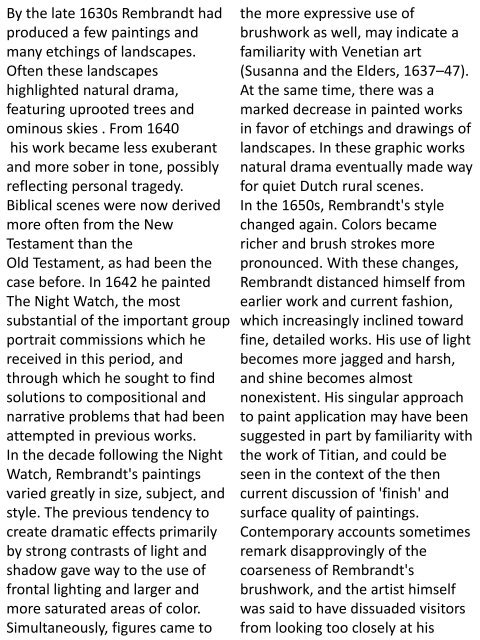Aziz Art January2018
History of art(west and middle east)- contemporary art
History of art(west and middle east)- contemporary art
Create successful ePaper yourself
Turn your PDF publications into a flip-book with our unique Google optimized e-Paper software.
By the late 1630s Rembrandt had<br />
produced a few paintings and<br />
many etchings of landscapes.<br />
Often these landscapes<br />
highlighted natural drama,<br />
featuring uprooted trees and<br />
ominous skies . From 1640<br />
his work became less exuberant<br />
and more sober in tone, possibly<br />
reflecting personal tragedy.<br />
Biblical scenes were now derived<br />
more often from the New<br />
Testament than the<br />
Old Testament, as had been the<br />
case before. In 1642 he painted<br />
The Night Watch, the most<br />
substantial of the important group<br />
portrait commissions which he<br />
received in this period, and<br />
through which he sought to find<br />
solutions to compositional and<br />
narrative problems that had been<br />
attempted in previous works.<br />
In the decade following the Night<br />
Watch, Rembrandt's paintings<br />
varied greatly in size, subject, and<br />
style. The previous tendency to<br />
create dramatic effects primarily<br />
by strong contrasts of light and<br />
shadow gave way to the use of<br />
frontal lighting and larger and<br />
more saturated areas of color.<br />
Simultaneously, figures came to<br />
the more expressive use of<br />
brushwork as well, may indicate a<br />
familiarity with Venetian art<br />
(Susanna and the Elders, 1637–47).<br />
At the same time, there was a<br />
marked decrease in painted works<br />
in favor of etchings and drawings of<br />
landscapes. In these graphic works<br />
natural drama eventually made way<br />
for quiet Dutch rural scenes.<br />
In the 1650s, Rembrandt's style<br />
changed again. Colors became<br />
richer and brush strokes more<br />
pronounced. With these changes,<br />
Rembrandt distanced himself from<br />
earlier work and current fashion,<br />
which increasingly inclined toward<br />
fine, detailed works. His use of light<br />
becomes more jagged and harsh,<br />
and shine becomes almost<br />
nonexistent. His singular approach<br />
to paint application may have been<br />
suggested in part by familiarity with<br />
the work of Titian, and could be<br />
seen in the context of the then<br />
current discussion of 'finish' and<br />
surface quality of paintings.<br />
Contemporary accounts sometimes<br />
remark disapprovingly of the<br />
coarseness of Rembrandt's<br />
brushwork, and the artist himself<br />
was said to have dissuaded visitors<br />
from looking too closely at his


















